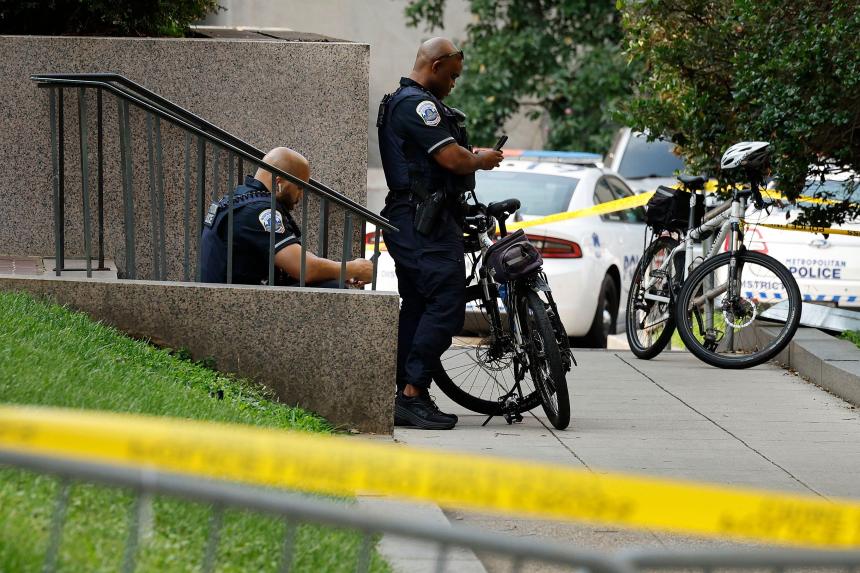WASHINGTON - Washington DC, once infamous as the murder capital of the United States, is suffering a relapse as crime soars.
As at Thursday, according to Metropolitan Police Department (MPD) data, violent crimes were up 39 per cent from the same period in 2022, with homicides alone up 28 per cent in 2023 to reach 190.
It is not uncommon to hear gunshots, as well as police and ambulance sirens, piercing the night.
Mornings reveal yellow police tape around roadside crime scenes, and roads lined with shattered glass from broken car windows.
Violent crimes have spread across the city to the so-called “good” neighbourhoods, and residents increasingly refrain from going out at night and avoid certain streets.
Residents and business owners in the capital’s small Chinatown are alarmed, saying people arrested by the police are seen back committing street crime within days.
Mr Michael D. Shankle, chairman of an advisory neighbourhood commission in Chinatown, said at a meeting in August that the neighbourhood has seen increasing violence over the past two years, with a lack of repercussions for those perpetrating crimes.
“We need solutions now,” he said. “It has been a slippery slope in which issues have not been addressed by our government leaders, and this has resulted in where we are today.”
Across the city, residents have been holding community meetings as concern grows. At one such meeting on Sept 6, called by a leading real estate agent and attended by The Straits Times, the police officer present was candid. “It’s out of control,” he said.
Police live in fear of being accused of brutality and suspended, he explained – a fear heightened after the 2020 killing of African-American George Floyd in Minneapolis. Mr Floyd, 46, died after a police officer knelt on his neck during an arrest for trying to use a fake US$20 (S$27) bill.
The incident triggered riots in several major US cities, with the police coming under increasing scrutiny. The officer was later convicted of manslaughter.
As a result of that scrutiny, young criminals are now not afraid of the police, the officer at the community meeting said.
But meetings like these usually address only the symptoms of a much deeper malaise, said a resident who researches crime and local histories in Washington and nearby Baltimore.
Many residents who moved to Washington and were not aware of the local histories did not fully appreciate the “decades of hyper segregation and discrimination” that its communities had been through, she said, asking not to be named, citing her employer’s rules.
“Economic opportunity was limited by race and class. You had decades of disinvestment in neighbourhoods, and that disinvestment eroded communities and the social fabric.”
The crime researcher said Washington has “one of the most militarised police forces in the country per capita”.
“There’s no doubt that the government’s capacity to hold people accountable needs to be improved – but we also need to invest in real solutions that connect young people especially to appropriate social services and to appropriate economic opportunities,” she added.
The African-American community in particular is both the source and the biggest victim of violent crime.
According to MPD data, more than 90 per cent of victims and suspects in 2019 and 2020 were male, and about 96 per cent were African-American.
The social fabric, particularly of the African-American community, has been eroded, long-time Washington resident Stanley Mayes, 73, told ST.
The retiree, who was born and grew up in the capital, now owns and runs a shoe and handbag repair shop. But he is also a former Wall Street banker and lawyer, and has often advised local police.
In part because of gentrification in Washington, the African-American community lost multi-generational households that used to look out for one another, he said.
As a result, he added, African-American teenagers in the city today are no longer in settings – be they family homes or churches – that provide them with discipline.
“But they still want US$400 sneakers and all the other stuff,” Mr Mayes said. “And they get it by robbing me or you.”
In one case in January, a 13-year-old, Aaron Blake, was shot and killed by a resident – who turned out to be a District of Columbia government employee – as he was apparently trying to break into a car. The incident took place at 4am.
“It was a tragedy, but what was a 13-year-old doing out on the streets at 4am?” Mr Mayes asked rhetorically.
The police, who not only wear body cameras but are also constantly recorded by the public, do not want to get caught doing anything they are not supposed to do, he said – echoing the police officer who spoke at the community event that ST attended.

The city authorities have responded with a range of initiatives, including a curfew for teenagers in selected neighbourhoods, and prosecuting juveniles as adults.
Many private buildings have installed an acoustic identification system that detects gunshots and, after triangulating with devices on other buildings, sends the location of the gunshot to the police, theoretically saving response time.
But critics say the technology does not improve the human relations that are key to policing.
There was a time when people knew the names of one another’s children within a 10-block radius, said the crime researcher who spoke to ST.
“They knew each other and the police walked the street. Today they don’t want to walk the beat because they are scared of walking. That is battlefield mentality.”


